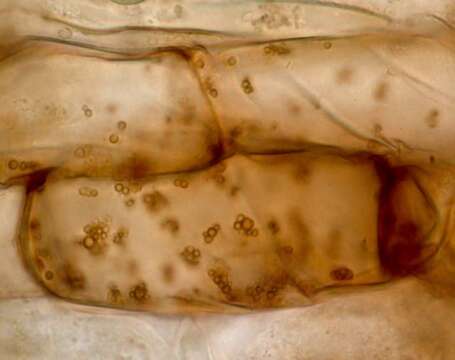Root parenchyma cells of Amaranthus viridis containing endophytic bacterium Pseudomonas sp

Description:
Description: English: Root parenchyma cells of Amaranthus viridis showing oxidizing protoplasts (brown staining) of bacterium Pseudomonas sp. in the periplasmic space (between plant cell wall and plant plasma membrane). Bacteria enter plant root cells at the root tip meristem, lose their cell walls forming protoplasts (L-forms), then bacteria are degraded by reactive oxygen (superoxide) secreted by NOX enzymes on the root cell plasma membranes), and surviving bacteria exit root cells from the tips of elongating root hairs. The cycling of bacteria between free-living soil phase and intracellular phase in roots has been termed 'rhizophagy cycle'. Bacteria acquire nitrogen and other nutrients in the soil phase, and nutrients are oxidatively extracted from bacteria in the root intracellular phase. This root tissue was stained with reactive oxygen stain DAB (diaminobenzidine; brown coloration) and counterstained with aniline blue to show blue protein contents of smaller non-oxidized bacteria.English: Root parenchyma cells of Amaranthus viridis showing oxidizing protoplasts (brown staining) of bacterium Pseudomonas sp. in the periplasmic space (between plant cell wall and plant plasma membrane). Bacteria enter plant root cells at the root tip meristem, lose their cell walls forming protoplasts (L-forms), then bacteria are degraded by reactive oxygen (superoxide) secreted by NOX enzymes on the root cell plasma membranes), and surviving bacteria exit root cells from the tips of elongating root hairs. The cycling of bacteria between free-living soil phase and intracellular phase in roots has been termed 'rhizophagy cycle'. Bacteria acquire nitrogen and other nutrients in the soil phase, and nutrients are oxidatively extracted from bacteria in the root intracellular phase. This root tissue was stained with reactive oxygen stain DAB (diaminobenzidine; brown coloration) and counterstained with aniline blue to show blue protein contents of smaller non-oxidized bacteria. Date: 14 March 2018, 12:11:08. Source: Own work. Author: James Francis White.
Included On The Following Pages:
- Life (creatures)
- Cellular (cellular organisms)
- Bacteria
- Proteobacteria (Purple Bacteria & relatives)
- Gammaproteobacteria
- Pseudomonadales
- Pseudomonadaceae
- Pseudomonas
This image is not featured in any collections.
Source Information
- license
- cc-by-sa-3.0
- copyright
- James Francis White
- creator
- James Francis White
- original
- original media file
- visit source
- partner site
- Wikimedia Commons
- ID


